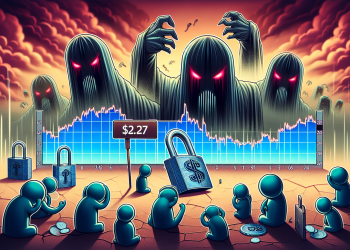Key Points:
- Webus International plans tokenized travel reward exchange using XRP stablecoin system
- Over $100 billion in loyalty points go unredeemed annually due to fragmented systems
- Platform will enable real-time conversion between different loyalty programs
- Nasdaq-listed company leverages Ripple’s infrastructure for instant settlements
Webus International, a Nasdaq-listed XRP treasury company, has unveiled ambitious plans to revolutionize the loyalty points industry by creating a tokenized travel reward exchange powered by the XRP stablecoin system. The Singapore-based firm announced last week that it aims to unlock value from what industry experts estimate to be over $100 billion in unredeemed loyalty points trapped in fragmented systems worldwide.
The company’s initiative addresses a fundamental inefficiency in consumer finance where billions of dollars worth of loyalty rewards remain unused due to the inability to transfer or combine points across different programs. According to McKinsey & Company, the global loyalty management market is expected to reach $18.2 billion by 2026, yet a significant portion of earned rewards never gets redeemed.
The Hidden Cost of Trapped Rewards
Every year, travelers accumulate hundreds of billions in loyalty credits across airlines, hotels, and mobility applications. However, these rewards often remain locked within individual ecosystems, creating what Hatem Kemali, co-founder of digital rewards platform Resal, describes as a massive inefficiency. “Points are trapped in broken, fragmented systems. Hard to track. Hard to combine. Hard to spend,” Kemali explained in a recent statement.
The problem extends beyond mere inconvenience. According to Collinson Group’s 2023 Loyalty Barometer, 77% of consumers want more flexibility in how they can use their loyalty points, with many expressing frustration at the limited redemption options available. Kemali noted that consumer expectations have evolved significantly: “Traditionally, loyalty points were earned after a purchase and redeemed in limited ways. But consumer expectations have changed today, people want to use loyalty like money, not just for discounts.”
This shift in consumer behavior represents the core opportunity that Webus International seeks to capture. The company’s platform promises to enable users to exchange and redeem points across multiple brands in real time, utilizing XRP-based stablecoin payments instead of traditional opaque accounting ledgers.
Turning Loyalty into Liquid Value
Traditional reward networks function as isolated economies where points from different providers cannot interact. A traveler might accumulate miles with Emirates, hotel points with Marriott, and ride credits with Grab, but these systems operate in complete isolation from each other. Webus’ blockchain framework aims to break down these barriers by tokenizing loyalty balances and connecting them through XRP’s infrastructure.
The platform will facilitate instant conversion between brands and regions without currency risk or manual reconciliation. Nan Zheng, CEO of Webus, emphasized the transformative potential: “By integrating XRP stablecoin settlement, we aim to bring real-time, low-cost, and transparent value conversion to the travel rewards ecosystem.”
While specific technical details remain limited, industry analysts suggest that the XRP Ledger (XRPL) will serve as the backbone of this initiative. According to Ripple’s documentation, the XRPL can process transactions in 3-5 seconds with minimal fees, making it ideal for high-volume, low-value transactions typical of loyalty point exchanges.
Why Ripple’s Technology Fits the Job
Ripple’s core settlement infrastructure was specifically designed to address multi-currency transaction challenges. The network enables institutions to move funds instantly without maintaining pre-funded accounts, using XRP as a bridge between local currencies. This architecture, which has proven successful in cross-border banking applications, provides a ready-made foundation for loyalty point conversion.
The integration of stablecoins aligns with Ripple’s broader strategy in real-world asset tokenization. RLUSD, Ripple’s USD-denominated stablecoin introduced last year, offers enterprises a regulated settlement option that is natively compatible with the XRPL. For Webus, this translates to stable, regulated liquidity, while for Ripple, it represents another expansion of XRP’s utility beyond institutional payments into consumer-facing applications.
According to research from the Bank for International Settlements, stablecoins can significantly reduce cross-border payment costs and settlement times, making them particularly suitable for loyalty point exchanges that require rapid, low-cost transactions across multiple jurisdictions.
Market Implications and Industry Impact
If successful, Webus International’s initiative could demonstrate how blockchain technology and stablecoins can solve tangible consumer problems beyond speculative trading. Instead of focusing on yield generation, XRP and RLUSD would power practical value exchanges in everyday transactions, effectively transforming loyalty points into a universal micro-currency for travel.
The timing appears favorable, as Allied Market Research projects the global loyalty management market to grow at a CAGR of 12.3% through 2031. Additionally, increasing regulatory clarity around stablecoins in major markets provides a more stable foundation for such initiatives.
The success of this venture could also validate Ripple’s long-term vision of creating an Internet of Value, where different forms of value can be exchanged as easily as information is shared today. By targeting a specific pain point in the consumer finance sector, Webus International may prove that blockchain’s real value lies not in speculation but in solving everyday inefficiencies.
Reader Question: As loyalty programs become increasingly digital and interconnected, how might the ability to instantly convert and spend points across different brands change your travel planning and spending habits?
What Does This Mean for Loyalty Program Members?
The tokenization of loyalty points could fundamentally alter how consumers interact with reward programs. Instead of accumulating points in isolated silos, members would gain the flexibility to optimize their rewards across platforms, potentially increasing the overall value they derive from loyalty programs. This shift could pressure traditional loyalty programs to offer more competitive redemption rates and broader partnership networks to remain relevant in an increasingly interconnected ecosystem.







